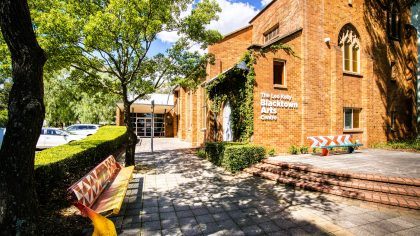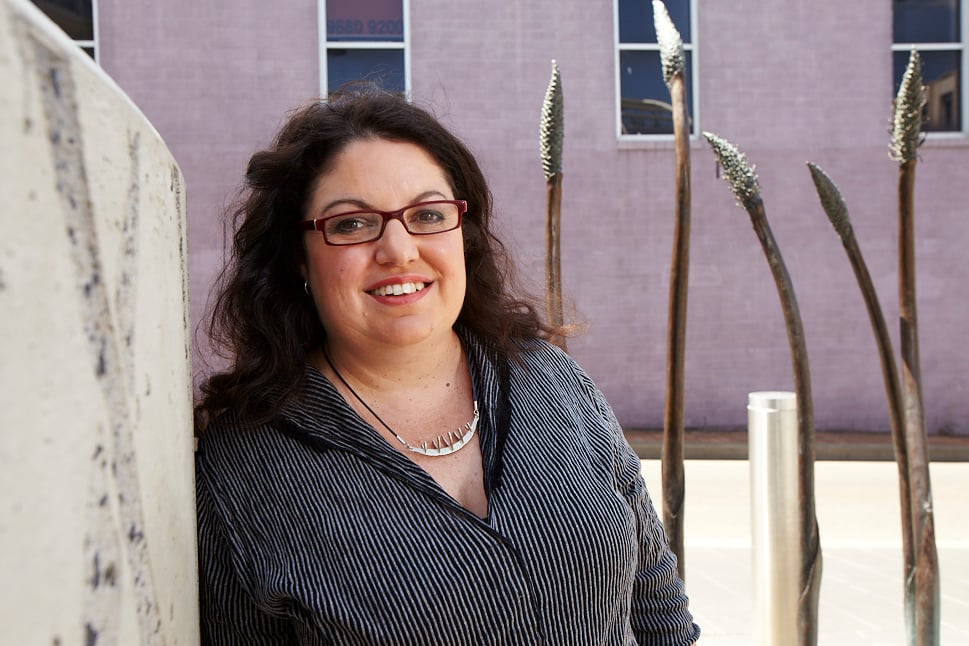
The Leo Kelly Blacktown Arts Centre
An innovative multi-arts hub in the heart of Blacktown City.
Bayadyinyang budyari Dharug yiyura Dharug Ngurra.
Bayady’u budyari Dharug Warunggadgu baranyiin barribugu.
Bayady’u budyari wagulgu yiyuragu Ngurra bimalgu Blacktown City. Flannel flowers dyurali bulbuwul.
Yanmannyang mudayi Dharug Ngurrawa. Walama ngyini budbud dali Dharug Ngurra Dharug yiyura baranyiin barribugu.
We acknowledge the Traditional Custodians of this Land, the Dharug people, and their continued connection to Country.
We pay our respects to Elders from yesterday to tomorrow.
We extend that respect to all Aboriginal and Torres Strait Islander Peoples of Blacktown City where the flannel flowers still grow proud and strong.
We will walk softly on this land and open our hearts to Country as the Dharug people have for tens of thousands of years.
Credit to: Dharug woman Rhiannon Wright, daughter of Leanne ‘Mulgo’ Watson Redpath and granddaughter of Aunty Edna Watson

For many years, the central theme in your studio works is migration and its aftermath. What draws you to this subject, and what sustains your interest in it?
I wanted to make art about things that are happening around me and things that I observe and think are important. Migration is an issue in Australian culture that is important, and it’s good for artists to be thinking about these things: to have a greater understanding of what it means to be in somebody else’s shoes, and to understand what other people have gone through. It’s not my own experience – it’s experience within the community, and I’m curious to learn what it is they’ve experienced.
Your practice alternates between studio and community-based projects. What is attractive about these different practices?
I really like working with people. When I work on public art commissions I want to engage with the community that is going to be living with the work. I’ve realised this engagement with community has become one of the strengths in my practice, and it’s something that I’m really attracted to, but I also find it can be quite exhausting. So that time in the studio on your own is another way of reflecting on those experiences. One feeds into the other. I also find developing a body of work on your own is very valuable and gives you time away from all that really hard work of engaging with people – it can be very stimulating, but it takes a different form of energy. I’ve also been taken with what the philosopher Roman Krznaric writes – the importance of empathy to balance out the focus on the individual in a consumerist world. We have been encouraged to focus on the individual, to search within ourselves. However, there is a need to look outside, to consider our place in and our impact on the world. Participating in socially engaged artwork can lead to an empathetic experience.
As a child were you creative?
Yes, I’ve always thought of myself as an artist. I can remember being five and thinking to myself, I’m either going to be an artist or a musician. I don’t know why I thought that because we didn’t know anyone who was either an artist or a musician. In my family it wasn’t thought to be a realistic career option. I was just really attracted to making things and to being creative. I played classical guitar and clarinet when I was growing up, but it wasn’t until I went to art school that I thought, ‘Ah, this is what I’m about. This is where my people are.’ All along I’ve felt like a real oddball, and now I fit in.
In 2006, you did a six-month residency in Hue, Vietnam. How has that experience influenced your work?
That was absolutely transformative – very much a life-changing experience. Although I hadn’t had much opportunity, I was itching to travel all of my adult life and finally I got the chance in 2004. I received an invitation to be part of a sculpture symposium in Vietnam, but I didn’t have enough funds to go there for the full month, so I was going to pass it up. Then I was given this great gift by the College of Fine Arts, UNSW. The Dean, Ian Howard, awarded me a grant to go there for three weeks and do some research and it was just fantastic. I didn’t have the chance to participate in the symposium, but I travelled around and met a lot of people. I met some terrific people at the Hue College of Arts and I came up with the idea for my sculpture Life Boat on that trip. It was two years before I could go back in 2006 and participate in the sculpture symposium collaborating with another Australian artist, Claire Martin.
We built a work – a public artwork – which is there in Hue, as part of the sculpture symposium. I then stayed for six months to work on the Life Boat project. I had really thought that work through, really knew what I wanted to do, and had fostered these relationships. That meant I had connections to help me realise the work – connections to help me get a studio space and accommodation, someone to help with translation, local craftspeople with boat-building skills who could help me with fabrication. It was a big time, and then I was offered the opportunity to display the sculpture in Hanoi at the Museum of Ethnology, and then to transport it to Sydney. It was a big risk, I didn’t have a budget for this, I just did it and it really paid off. It was exhibited in Sculpture by the Sea, and then selected for the Helen Lempriere Awards where it won the Popular Choice, and then it was purchased by artsACT and is permanently on display in the Civic Library, Canberra. It was a huge turning point in my career and my life. It made me feel free because I realised I could make something so big, and take a big risk.
Tell us what that work is about, and how it fits into your migration theme.
When I was growing up in Perth, I knew Vietnamese people who had come here by boat. So when I went to Vietnam, I thought about that issue, but in Vietnam, obviously I didn’t want to make a work about boat people. The work is about boats, and life on the water and its spiritual significance in Vietnam. But when I moved the work from Vietnam to Sydney, a shift in the meaning occurred. The work was inspired by the bodhisattva, the multi-armed deity. Instead of oars, it has arms. The hands are carved from recycled timber – wood from old Vietnamese houses – and coated in Vietnamese lacquer. The work is about compassion and connection, but when I exhibited it in Sydney, Vietnamese people identified with it differently – they told me it articulated the story of their journey here. In fact a friend who had come here by boat purchased the smaller version, the maquette, and wrote a story about his journey in response to the work. It was an issue that I thought a lot about. It’s not my own experience, but rather the work grew in meaning by knowing people and listening to their migration stories.
Your work often distils complex meaning in a single motif, for example, the anchor featured in the Diaspora-Making Machines exhibition.
Why did you choose this motif?
Sometimes things just come together like in the Life Boat – the boat and the arms. It’s almost magical. You know you want to make a work about boats and then you see the arms and then the arms become the oars of the boat and that just works. With the anchor – I knew I wanted to make a work about an anchor. My father was a sailor and at the front of our house he had installed an anchor. As a child I used to think that the anchor was holding the house down. Years later, some 25 years later in fact, I went back to see the old house and the anchor was still there, so that stayed in my mind. The trigger for using it as a motif in a sculpture was witnessing the largest number of people displaced in Europe since World War II. In 2015, on television screens, from the comfort of our lounge rooms, we watched waves of displaced people at sea in small flimsy boats, being hoisted from the ocean, or walking long distances in search of freedom. I was feeling a mix of empathy and powerlessness.
The sculpture speaks of opposition – the anchor symbolising safety and security. However, this anchor is covered in checked plastic – the type associated with cheap carry bags, poverty and mobility. I also recently read this story by Debra Adelaide called ‘The Master Shavers’ Association of Paradise’ (in A Country Too Far, 2013, eds Rosie Scott and Tom Keneally). It’s about a man, a refugee, who was given one of those plastic carry-all bags, but he had so few belongings to put in it that it just looked like a crumpled heap. I thought about that checked plastic and how everyone has a relationship with it. We use it to move our belongings from one house to another, but what if that was the only thing you had to contain all your belongings and what if, even then, everyone else’s looked like a nice square little brick and yours just looked like a crumpled heap. That story really struck me. So in that way the two things came together – the anchor being about security, being anchored and the plastic being about poverty and mobility.
Exhibition | Diaspora-Making Machines
Thursday, 29 September – Saturday, 5 November 2016
Diaspora-Making Machines is an exhibition that explores the systemic devices (the machines) that generate movement and the dispersal of communities (the diaspora). Blacktown is a site of continuous waves of migration. Since Governor Macquarie issued the first land grant to Nurragingy and Colebee in 1816, communities have been moving to Blacktown – sometimes by choice, sometimes by force. Eight artists engage with Blacktown’s historic place as a centre of migration, our attitudes to newcomers, and notions of belonging and assimilation.Elin Howe is an art historian and writer with an interest in contemporary art. She has taught art history/theory at university and TAFE.